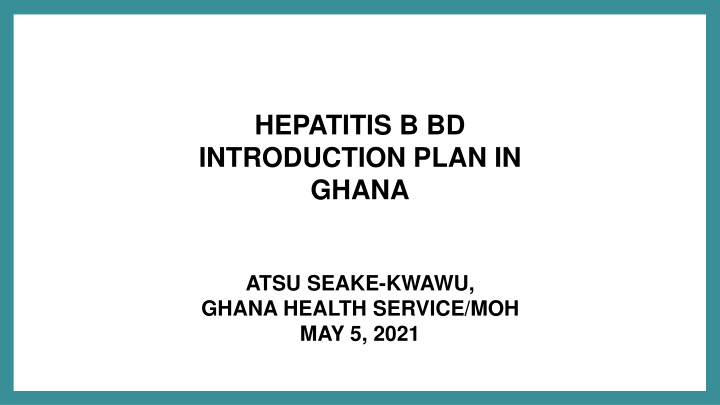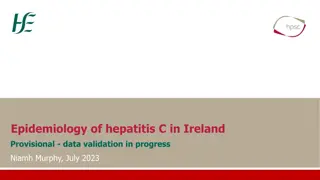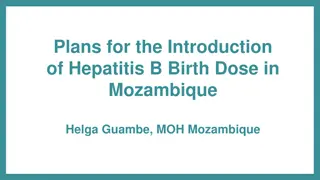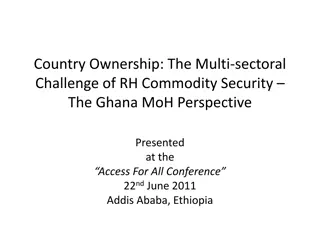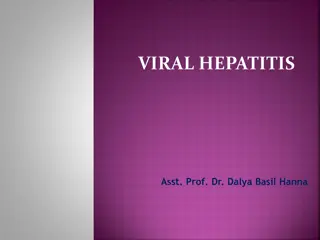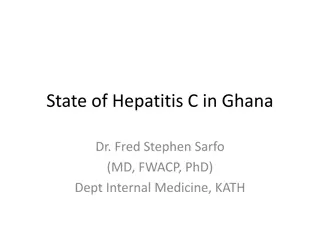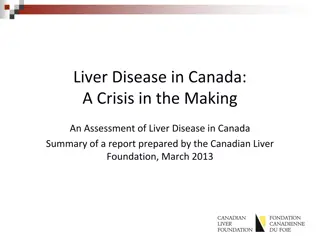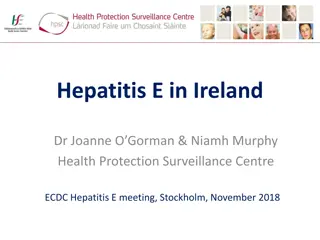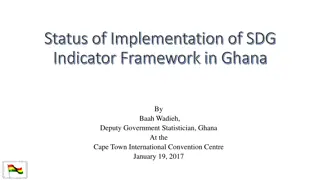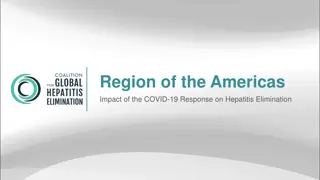Hepatitis B BD Introduction Plan in Ghana
In Ghana, the introduction plan for Hepatitis B BD involves evaluating disease burden, estimating seroprevalence among pregnant women, obtaining necessary approvals, presenting evidence to NITAG, and seeking support for introduction. A policy for screening and prevention is in place, aiming to address the burden of Hepatitis B, which affects both the general population and pregnant women. The current process includes steps to gather crucial data and secure approval for the introduction of Hepatitis B BD vaccine in Ghana.
Download Presentation

Please find below an Image/Link to download the presentation.
The content on the website is provided AS IS for your information and personal use only. It may not be sold, licensed, or shared on other websites without obtaining consent from the author.If you encounter any issues during the download, it is possible that the publisher has removed the file from their server.
You are allowed to download the files provided on this website for personal or commercial use, subject to the condition that they are used lawfully. All files are the property of their respective owners.
The content on the website is provided AS IS for your information and personal use only. It may not be sold, licensed, or shared on other websites without obtaining consent from the author.
E N D
Presentation Transcript
HEPATITIS B BD INTRODUCTION PLAN IN GHANA ATSU SEAKE-KWAWU, GHANA HEALTH SERVICE/MOH MAY 5, 2021
Ghana Background Population: 30,955,204 (GSS, 2020 est) CBR: 28.826 births per 1000 Expected births (2020): 892,314 Women s health At least one ANC visit-97% At least 4 ANC visits-87% Deliver in health facility-73% GSS.DHS.2014
Ghana-BCG, OPV0 and Penta3 coverage trends BCG, OPV0 and Penta3 coverage, 2016-2020 120 103.5 98.4 98.4 95.6 100 93 99.9 99.9 99.4 98.6 96.9 80 Coverage (%) 75.3 74.8 74.7 74.7 71.4 60 40 BCG OPV0 Penta 3 20 0 2018 Year 2016 2017 2019 2020
Estimated burden of Hepatitis B using HBsAg prevalence General population- 12.3% (Ofori-Asenso and Agyeman, 2016) Pregnant women-Unknown (but 12% median prevalence estimated of 4 hospital- based studies published before 2014) Subject of ongoing CDC-funded Seroprevalence study Children <5 years- 0.64% (0.50%-0.80%) Modelled data IHME, 2019 Ofori-Asenso, R. and A.A. Agyeman, Hepatitis B in Ghana: a systematic review & meta-analysis of prevalence studies (1995-2015). BMC Infect Dis, 2016. 16: p. 130. Breakwell, L., et al., The status of hepatitis B control in the African region. Pan Afr Med J, 2017. 27(Suppl 3): p. 17.
Current Process for the HepB BD Introduction Hep B-BD described as potential new vaccine in cMYP 2015-2019 for introduction in 2017 NITAG required evidence of disease burden before introduction In 2020 CDC/WHO/GHS/NMIMR developed protocol to estimate the seroprevalence of hepatitis B among pregnant women using 2019 HIV Sentinel survey samples Necessary approvals have been obtained for study to start Evidence obtained will be presented to NITAG for evaluation Hepatitis Programme will disseminate the results to wide stakeholder platforms to build support and expectation for BD Once NITAG approves, application will be submitted by EPI to GAVI to support Government of Ghana to introduce BD
Hepatitis B Screening and Prevention Policy Ghana New Maternal and Child Health Record
Hepatitis B Screening and Prevention Policy Policy on preventing mother to child transmission of HBV is incorporated into RMNCAH policy in principle HBsAg screening of pregnant women on-going but not reported Multiple rapid test kits in use of doubtful approval status National Programme has not yet developed Testing policy/algorithm Treatment guidelines for infected pregnant women are yet to be updated to reflect current WHO recommendations Interventions to prevent MTCT_HBV are not yet on public offer Imported HBIG and Birth dose HB are available in privately in some cities
Challenges Facing The Hepatitis B Birth Dose Programme Most important challenge now is obtaining early data for NITAG decision Other foreseen challenges include Orienting midwives to accept birth dose vaccinator role within labour wards with all its accompanying responsibilities Documentation Accessing EPI cold chain/ maintenance Reporting Reaching newborns born outside health facilities within 24 hours Early information flow Availability of staff to vaccinate at home Appropriate transport means availability at time of need
Opportunities For Hepatitis B BD Introduction Research TA is available from CDC and WHO for evidence generation A second study on Risk of Mother to Child Transmission of Hep B has been submitted for ethical review Funding has been secured for both studies through CDC National cold chain capacity in every district Midwives already used to Vitamin A administration within 72 hours Midwives already administering ARV prophylaxis to HIV-exposed newborns Decentralized service delivery with nurses placed within communities (CHPS zones)
